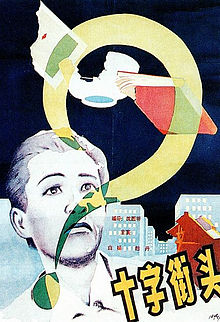Crossroads (1937 film)
| Crossroads | |
|---|---|
 |
|
| Traditional | 十字街頭 |
| Simplified | 十字街头 |
| Mandarin | Shízì jiētóu |
| Directed by | Shen Xiling |
| Written by | Shen Xiling |
| Starring |
Zhao Dan Bai Yang |
| Cinematography | Zhou Shimu Wang Yuru |
|
Production
company |
|
|
Release date
|
|
|
Running time
|
110 minutes |
| Country | China |
| Language | Mandarin Chinese |
Crossroads is a 1937 Chinese seriocomedy film directed by Shen Xiling, starring Bai Yang and Zhao Dan. The film exemplified the growing trend of Chinese films by the mid-1930s of incorporating references (both veiled and explicit) to the war with Japan. In this way, Crossroads joins films like Blood on Wolf Mountain by Fei Mu and The Big Road by Sun Yu.
Crossroads has its background in the Great Depression of the 1930s. Produced by Mingxing Film Company, the film also represented an expansion by Mingxing into the leftist film market that had been dominated by its rival Lianhua Film Company, due to a flagging financial situation.
In 2001, a sequel was made, despite the half-century gap, entitled New Crossroads.
The film begins at a dock at Shanghai, where college graduate Xu is contemplating suicide because he cannot find a job. His friend Zhao (Zhao Dan) stops him, and leads him back to their rented apartment. We learn that the four graduate friends are all jobless. Zhao serenades to Xu and dissuades him from thoughts of suicide, asking him to concentrate on his freelance translation job instead. Xu tells Zhao he has decided to sell his degree in order to raise funds to see his mother in the countryside. His other friend Tang comes to celebrate his own birthday with a fourth friend, Liu.
A female college graduate Yang (Bai Yang) comes to Shanghai to look for a job, and rents the room beside Zhao's. Meanwhile, Zhao finds a job at the press. Jubilant, he washes his laundry and hangs them up on a pole that extends into his neighbour's room. Yang is napping, and the wet laundry drips her pillow damp. Yang's friend comes in and bangs a few nails for her to hang her clothes, and Zhao's framed photos fall off at the opposite side of the wall.
...
Wikipedia
